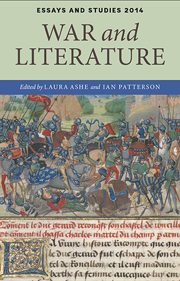Book contents
- Frontmatter
- Contents
- List of Illustrations
- Notes on Contributors
- Preface
- I IDEOLOGIES
- II INTERPRETATIONS
- Crossing the Rubicon: History, Authority and Civil War in Twelfth-Century England
- ‘The Reader myghte lamente’: The sieges of Calais (1346) and Rouen (1418) in chronicle, poem and play
- Shakespeare's Casus Belly; or, Cormorant War, and the Wasting of Men on Shakespeare's Stage; or, Eating Wars and Digesting Plays; or, The Art of Chucking Men Into Pits; or, Shakespeare, Tacitism, and Why Plato Don't Matter
- Unnavigable Kinship in a Time of Conflict: Loyalist Calligraphies, Sovereign Power and the ‘Muckle Honor’ of Elizabeth Murray Inman
- Proclaiming the War News: Richard Caton Woodville and Herman Melville
- III AFTERMATHS
- Index
Proclaiming the War News: Richard Caton Woodville and Herman Melville
from II - INTERPRETATIONS
Published online by Cambridge University Press: 05 October 2014
- Frontmatter
- Contents
- List of Illustrations
- Notes on Contributors
- Preface
- I IDEOLOGIES
- II INTERPRETATIONS
- Crossing the Rubicon: History, Authority and Civil War in Twelfth-Century England
- ‘The Reader myghte lamente’: The sieges of Calais (1346) and Rouen (1418) in chronicle, poem and play
- Shakespeare's Casus Belly; or, Cormorant War, and the Wasting of Men on Shakespeare's Stage; or, Eating Wars and Digesting Plays; or, The Art of Chucking Men Into Pits; or, Shakespeare, Tacitism, and Why Plato Don't Matter
- Unnavigable Kinship in a Time of Conflict: Loyalist Calligraphies, Sovereign Power and the ‘Muckle Honor’ of Elizabeth Murray Inman
- Proclaiming the War News: Richard Caton Woodville and Herman Melville
- III AFTERMATHS
- Index
Summary
How does the role of public speech evolve in an age of technological transformation? Two literary and visual artefacts from the wars of nineteenth-century America pose this question, and offer insights into a chapter of media history that is still poorly understood. In the first, Richard Caton Woodville's War News From Mexico (1848), the ambivalent place of wartime voice takes centre stage. This most iconic of genre paintings records a foundational scene of US imperialism, and captures the public drama of national expansion. Its broader subject, however, is the social life of information. Woodville's image depicts news of Mexican surrender to Federal forces processing outwards from the central rectangle of crumpled text, intersecting with the geometry of the porch, the hotel, the post office insignia, the recruitment poster and the canvas itself. Through the isolated female onlooker and African American pair – who are all held, along with the viewer, at one remove from participation – we are shown how information excludes. Through the whisperer who relays the news to one of the hat-wearing men, we watch information being mediated.
But this is an image as much of performance as dissemination: upon the proscenium arch of the ‘American Hotel’ the public square becomes civic theatre, the setting for a ritual that Woodville wants us to imagine repeated in countless small towns as news of war diffuses through the republic. The waistcoated businessman proclaiming the news becomes a demotic mock orator of the Declaration and his newspaper – tattered from previous readings – is given life, its columns reanimated for the crowd.
- Type
- Chapter
- Information
- War and Literature , pp. 163 - 182Publisher: Boydell & BrewerPrint publication year: 2014

